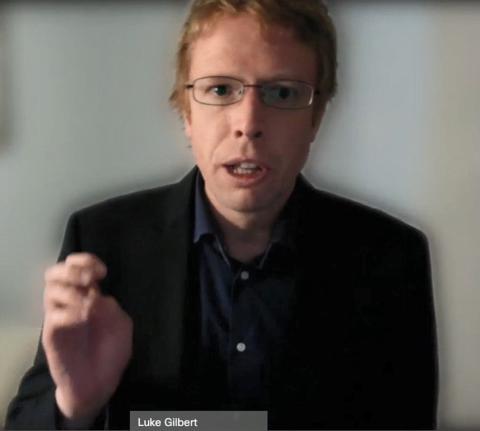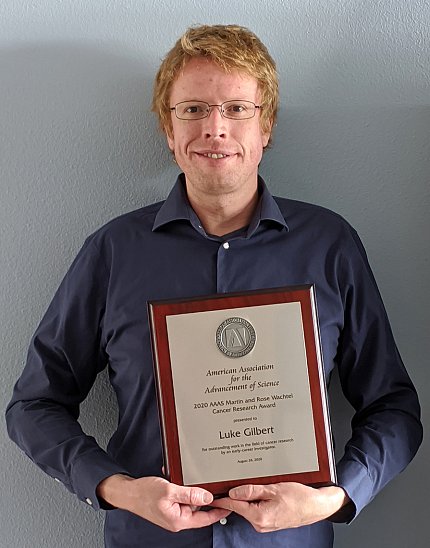Wachtel Winner
Gilbert’s Research Paves Way for New Cancer Drugs

The potential to develop new, more effective cancer drugs may be bolstered by a process akin to flipping a switch, or perhaps many switches. One young biologist’s pioneering work in gene regulation—turning genes on and off—is paving the way for advances in cancer research.
Dr. Luke Gilbert, assistant professor at the University of California, San Francisco, heads a lab that models and maps how genes function and interact in health and disease. Their experiments aim to reveal which genes and genetic interactions drive cancer progression and response to treatment.
“It’s really the early-career investigators who make some of the most important contributions in the field,” said Dr. Tom Misteli, director of NCI’s Center for Cancer Research, at a recent CCR Grand Rounds held virtually via WebEx. This year, he added, it’s especially important to recognize and support promising young researchers, many of whom continue to face tough research challenges during the pandemic. “We have to make sure…they can build their careers despite all the difficulties and the slowdown at the moment.”
Gilbert delivered the 8th annual AAAS-sponsored Wachtel Lecture, co-hosted by NCI, during which he was honored with the Martin & Rose Wachtel Cancer Research Award, which comes with a $25,000 prize from the Wachtel endowment. The award recognizes the outstanding contributions of early-career cancer investigators.
Gilbert’s contributions are enabling previously impossible experiments. His lab at UCSF developed CRISPR-based genetic screens for manipulating genes within human cells.
“These tools represent a new ability to turn endogenous human genes off and on, or up and down, flexibly and in a quiet way where, in one cell, we can turn one gene off and another gene on,” said Gilbert. “What’s perhaps more useful is to be able to, in a single experiment, turn every gene off or every gene on, and we’ve shown that we can do this.”

Gilbert’s lab chose a chronic myeloid leukemia cell line for its first-ever CRISPRi/a—a combination genome scale screen he designed to analyze large groups of gene pairs. By turning genes off, Gilbert’s team could see the genes required for cell proliferation and cell survival. Then, by zooming in, they found that a third were tumor suppressor genes. The deeper they probed, the more they learned about gene function and cell health, prompting further experiments.
The approach is shedding light on how oncogenes and tumor variations affect a patient’s response to cancer therapies. For example, Gilbert’s lab began studying a new class of cancer drugs that can inhibit the oncogene KRASG12C.
“Mutant KRAS is a major driver of tumorigenesis and drug resistance,” Gilbert explained in his AAAS Wachtel Prize essay, published in Science Translational Medicine. “However, until recently, this oncogene was considered undruggable.”
New KRAS inhibitor drugs are now in phase 1 and 2 clinical trials to treat non-small cell lung cancer (NSCLC), colon cancer and pancreatic cancer, said Gilbert. But responses have varied. Some patients have acquired drug resistance, leading Gilbert to further explore which genes are controlling reactions to these drugs and how to improve response.
“The key here is that these drugs…are nontoxic, meaning we can leverage them into combination therapies,” he said. And that was their next step. When they combined the KRAS inhibitor with another FDA-approved drug—a CDK4 inhibitor that had already gone through phase 3 trials for NSCLC—this induced a nearly complete tumor regression in a mouse model.
“We’re really excited. There’s a clinical trial testing this hypothesis right now,” Gilbert said, “and it really would be a huge win, I think, for functional genomics if this was a useful combination therapy.”

The work Gilbert described thus far illustrates genetic interactions that perturb a single gene. “By analogy, that’s like me as a 5-year-old just coming up to a piano and banging one key again and again, at an annoying, really loud intensity,” said Gilbert, intent on moving beyond single-gene perturbations toward something closer to a genetic concerto.
Gilbert found inspiration in yeast genetics. “The key insight, I think, from the yeast field was that studying the relationship between pairs of genes is useful, but studying hundreds to thousands of pairs of genes is even more useful, and not just in a sense that you get more data,” he said, “ but there [are] actually emergent properties from large datasets that are useful for annotating gene function.”
Perturbing large sets of genes and clustering them by function in yeast yielded new information about previously uncharacterized genes, giving rise to the idea to run such experiments in human cells. Gilbert has since designed genetic interaction maps using CRISPRi/a that can measure hundreds of thousands of interactions in a single experiment. The maps cluster genes into known protein complexes and pathways, he said, helping researchers classify individual genes and identify rare synthetic lethal gene pairs.
Gilbert harkened back to the beginnings of genetics, when Gregor Mendel studied how gene pairs influenced complex phenotypes such as flower color or pea shape.
“Human cells obviously don’t have flowers and peas, but can use the transcriptome as a complex readout of cell state,” said Gilbert. Some of his latest experiments involve pooling CRISPR screens and perturbing pairs of genes, using a single-cell RNA-sequencing platform called Perturb-SEQ, to measure stasis relationships at the level of the transcriptome—that is, all gene readouts present in a cell.
“Where I think we should be going as a group of biologists is towards trying to perturb pairs of genes and sets of genes, and turn them on and off in different combinations,” said Gilbert. “Essentially, if we do this at a very large scale, we’ll let biology speak to what’s important in creating cell function.” This research could have a range of therapeutic applications, not only in cancer but also across all of biology.
